A Safer, Better Austin Street
By Pedro RodriguezWith 2023 behind us and the City finally paying attention to Austin St, we must start to consider: what exactly do we want Austin Street to look like?
So far, Neighbors for A Safer Austin Street has avoided proposing specific changes and instead advocated for a study. But during this whole time, many conversations have had, and many people have put up different ideas. In this article, we will discuss some of these ideas and hopefully help the community at large come up with a plan for a Safer, Better Austin Street. Understanding the issues and possible solutions will be useful when the City and DOT come to the community with ideas.
Understanding the issues
Before we can speak about solutions, we must consider what the root issues are on Austin Street. The issues can be reduced to four points: too many cars, inefficient traffic flows, too many people, and too little space.
Too Little Space
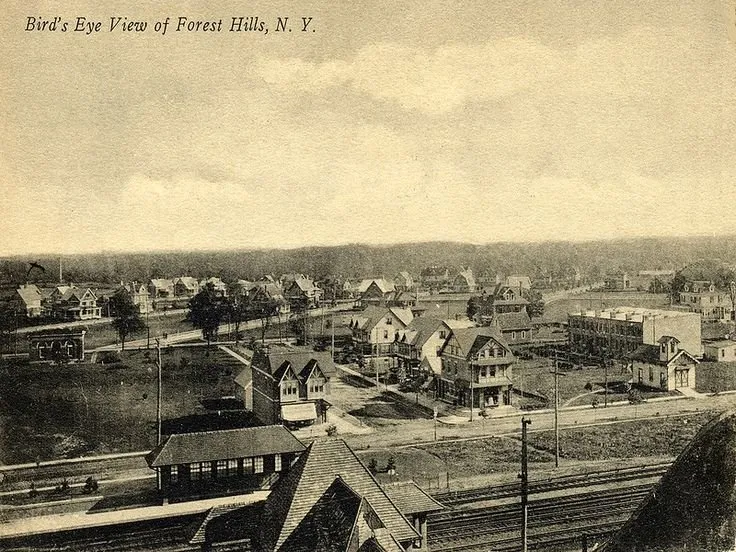
LIRR Station and Austin St, circa 1910-1915. Michael Perlman Postcard Collection
The roadways in Forest Hills were laid around 1910. Back then, this area was countryside; cars were starting to enter the general population, but they were small and few; horses still pulled carts around. The narrow sidewalks of Austin Street would have fit perfectly in this world.
Since then, there has been little to no change to the streetscape, even though we’re now living in a much denser neighborhood, and cars have become gigantic by comparison and much more common.
Widening the street is out of the question, as such a change would require removing the sidewalks and possibly demolishing buildings (many historic). This means we need to be smart with the little space we have.
A redesign must look at the current space and see how we can maximize its use equitably and intelligently.
Too Many Cars
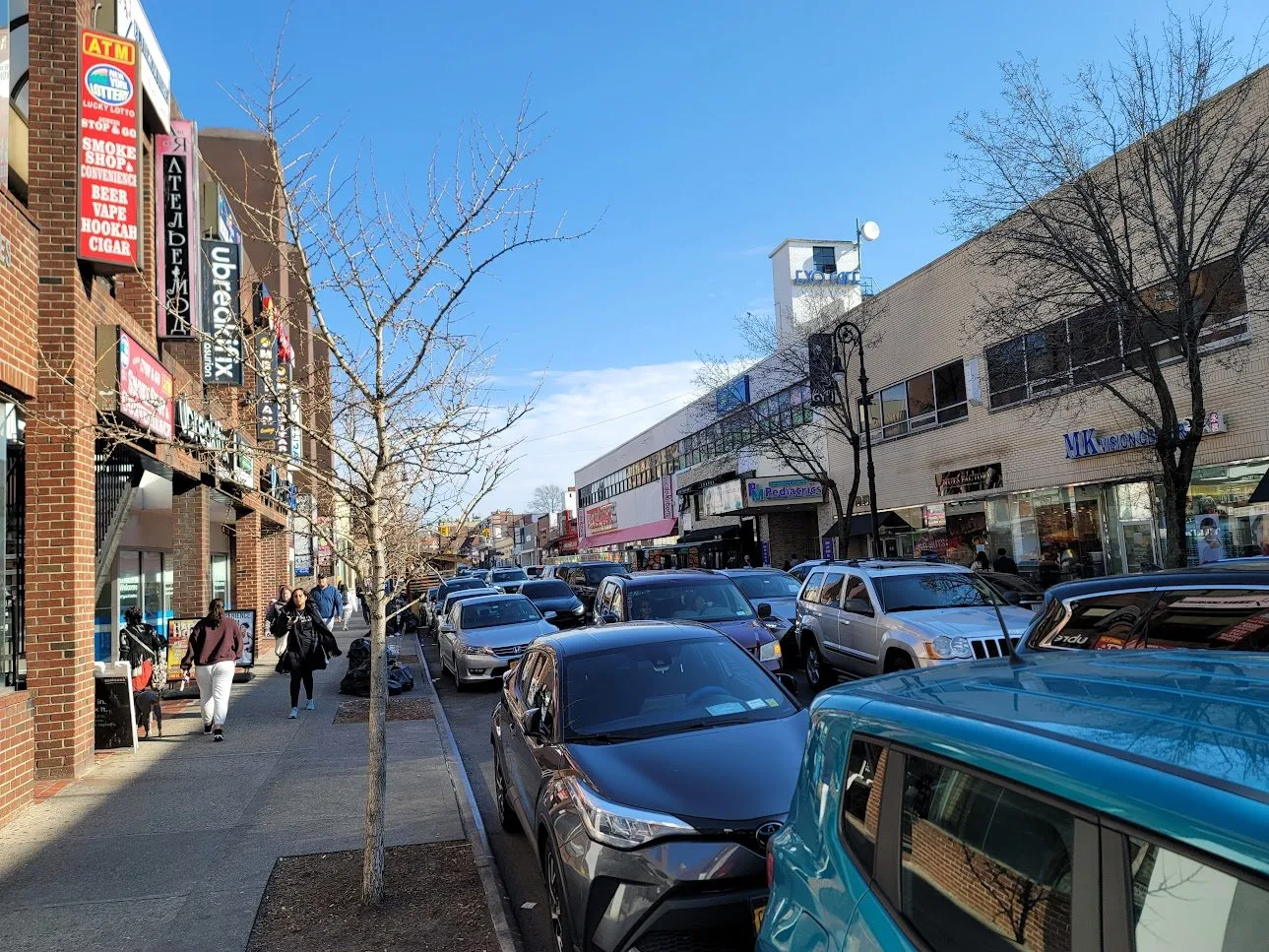
A common sight on Austin Street: too many cars
This one seems obvious: there are too many cars on Austin Street. A lot of this traffic is necessary, such as deliveries, people making pick ups and drop offs, and the bus, but some of this traffic is unnecessary.
Austin St has fewer lights than the parallel, much larger Queens Blvd. Austin St has no lights east of Ascan Ave, nor between Continental and Ascan Ave. This means people can (and do) use it as a thru-way to bypass Queens Blvd. None of this traffic helps the commercial strip; instead, it creates more congestion, damaging its attractiveness.
A redesign should consider removing thru-traffic from Austin St itself, that way all vehicles on the strip are only vehicles bound to or from the strip. Thru traffic should be aimed at the larger, more capable Queens Blvd.
Inefficient Traffic Flows

The Austin St + Continental Ave intersection has a pedestrian scramble light cycle. Though safer for pedestrians, it often leads to traffic building up in all directions.
Austin Street is a narrow street with two-way traffic on two lanes, with no turning lanes. This means whenever a car wants to turn, it will create traffic for cars behind it. This can be made worse if pedestrian traffic stops the car from making the turn. When you combine this issue with traffic lights, which stop traffic altogether, you have the recipe for gridlock.
Austin Street has traffic lights close together (west of Continental Ave) and a pedestrian scramble (Barnes Dance) at the Continental Ave intersection. While this increases pedestrian safety, it means cars are stuck for longer. To make matters worse, as is common in NYC, pedestrians often cross without light, blocking turning vehicles even when they have the light at the Scramble.
Add to this truck and bus traffic, which takes much more space, and it’s no surprise that Austin Street is often clogged.
A redesign of Austin Street should simplify traffic patterns while ensuring pedestrian safety is a priority.
So many people
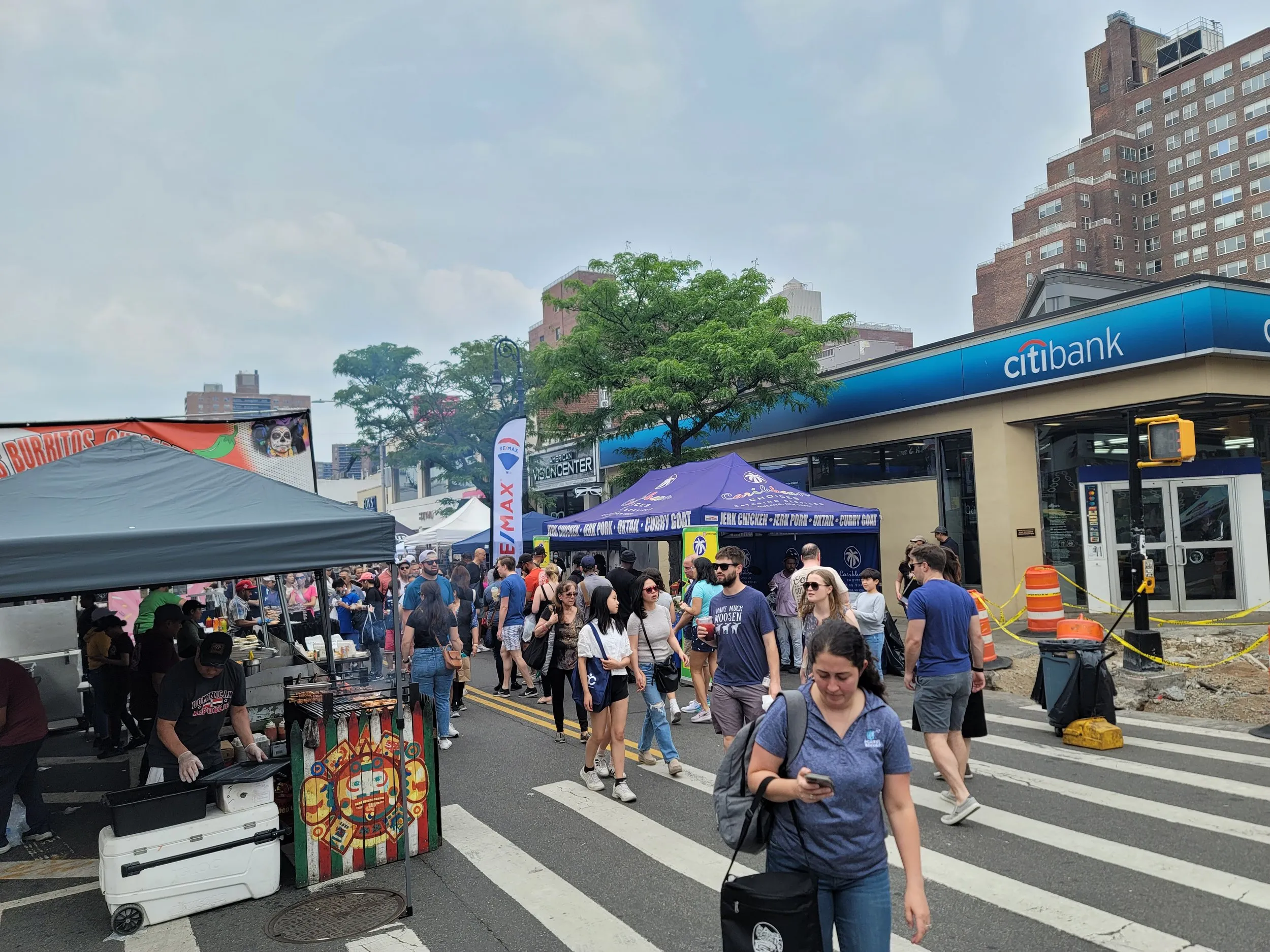
Austin Street attracts a lot of pedestrians, yet gives the least amount of space to them. The Austin Street Fair shows how many more people could visit Austin Street if more space is made for pedestrians.
Austin Street has:
- A lot of businesses, all close together and easily walked between
- A LIRR station
- A subway station with four lines, two express
- A bus going through it (Q23)
- Several buses stop nearby, some express to Manhattan
- The Queens Blvd Bike Lane
- It is surrounded by medium and high-density housing, all within walking distance.
- The expansion of CitiBike to Elmhurst has brought many people using that service.
Due to these, it is not surprising that Austin Street has a lot of people—too many for the narrow sidewalks built over 100 years ago. The crowded sidewalks are often an obstacle for people who need more space to move around, such as wheelchair users and parents with strollers.
The high concentration of people and businesses, combined with the narrowness of the roadway, often invites pedestrians to cross midblock or against the light, creating a hazard for pedestrians.
And with all new developments going up on Queens Blvd and around the district, Austin Street will become more crowded.
A redesign of Austin Street should prioritize space and safety for pedestrians, as they are the most numerous strip users. It should also expand pedestrian space to facilitate future growth.
With these in mind, let’s look at possible solutions and their pros and cons.
Disclaimer
These ideas were written before the Q23 bus redesign: the Q23 bus no longer goes down Austin Street. Since the redesign is followed by monitoring of every line, which could lead to further changes, we’re keeping the ideas as written (in case it comes back).
On of the ideas, the Busway idea, could even allow the MTA to bring it back.
Ideas for a Safer, Better Austin Street
We will be presenting three ideas, each one with Pros and Cons. At the end, there will be a survey where you can tell us which one you prefer and why! As well as provide your own ideas.
One Way, One Lane, Westward
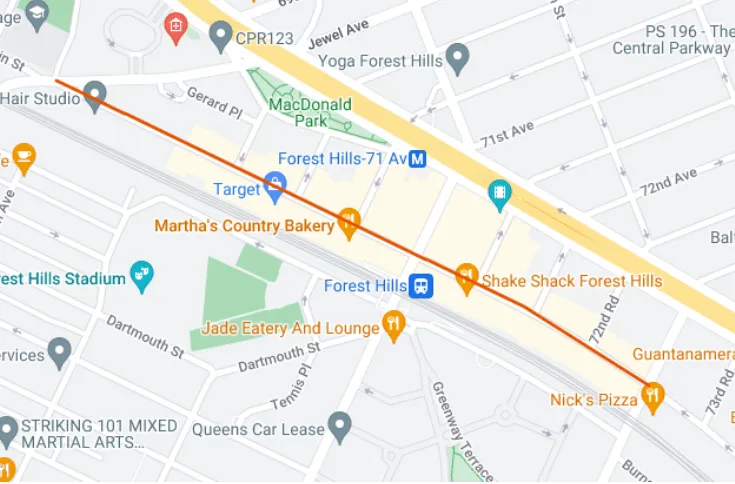
One way, One Lane, Westward. With a counterflow bike lane.
This idea turns Austin Street into a one-way, one-lane westbound. It continues the traffic pattern currently existing east of Ascan Ave. A counterflow bike lane is added to discourage sidewalk riding. Since the street is reduced to one lane, parking can be moved closed inwards, opening up space for sidewalk expansion.
Pros
- Simplifies traffic in one direction.
- Doesn’t remove much parking.
- If parking is removed, sidewalks can be expanded even more.
- If turned into a shared street, it could become a nice space.
Cons
- Removes the bus.
- Can induce speeding.
- This could be mitigated with a shared street design.
- Does not provide as much lingering space for pedestrians
- Does not eliminate congestion and hazards; just reduces them
- This could be mitigated with a shared street design.
- Does not eliminate congestion from thru traffic (in fact, it prioritizes west-bound thru traffic)
- If a shared street design is implemented, thru-traffic, though still possible, would be heavily discouraged
Localized Pedestrianization
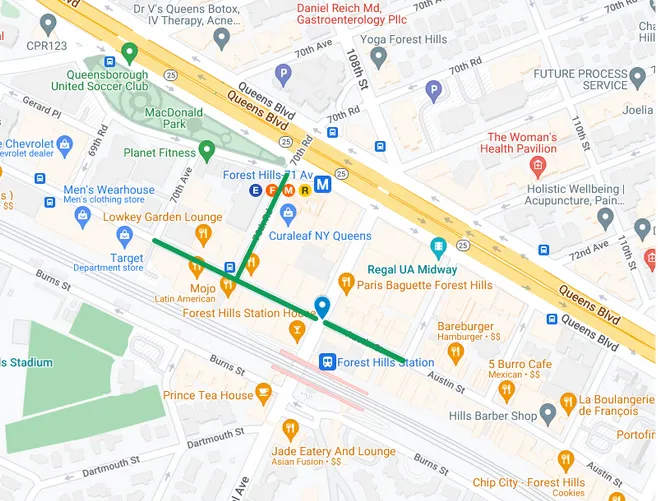
Pedestrianize the area around 71st/Continental Ave.
This solution would allow Restaurant Row and the strip between 70th Ave and 71st Rd to be pedestrianized while keeping 71st/Continental Ave north-south traffic. The northern end of Restaurant Row would allow two-way, slow traffic to enter and exit the two driveways.
Bike lanes may be necessary in some pedestrian areas to segregate bike traffic from the pedestrian space. The bike lanes could also double as emergency lanes.
Pros
- Massive increase in pedestrian space
- Eliminates congestion and hazards
- Eliminates thru-traffic, prioritizes local car traffic
- The new pedestrian space would be big enough to hold frequent community events
- Provides more space for outdoor activities, like dining and public seating
- Removes turns on 71st Ave, which is a main cause of all the traffic.
- North-south traffic is kept and made more efficient.
Cons
- Removes the bus
A note on the Austin Street Fair Proposal
Another version of this exists, which covers the entire area from Yellowstone Blvd to Ascan Ave and from Queens Blvd to Austin Street, which we will call the “Austin Street Fair Proposal,” named after the area the twice-a-year Austin Street Fair covers.
This idea can work as well, but it would require that access be kept to all driveways. This is a complex idea, and we leave it to the reader to experiment with it.
Pedestrian Areas and a Busway
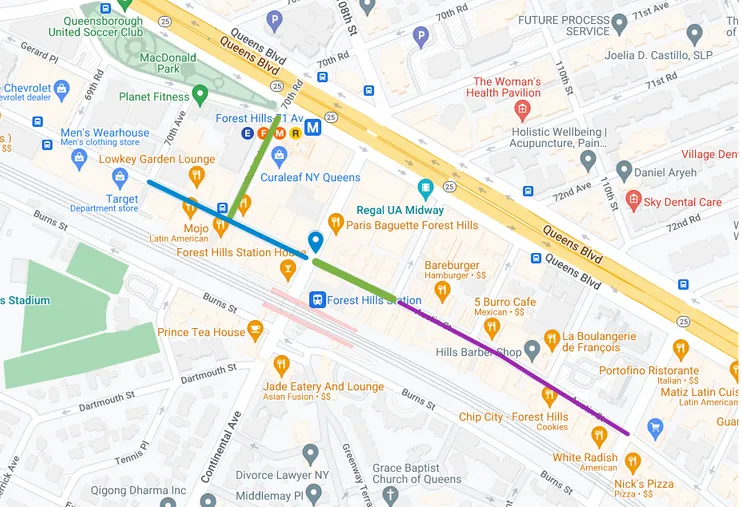
A combination of the previous two plans, plus a busway
This is the more complex of the plans, but it has one advantage: it keeps the bus and fixes it. The two blocks west of 71st Ave are where traffic most often reaches gridlock, causing the bus to move painfully slowly. This plan calls for turning those two blocks into a busway, an area only buses can enter (see 14th Street in Manhattan and Jamaica Ave next door for examples). Truck delivery may be allowed, either all the time or partially.
Restaurant Row and one block east of 71st Ave are turned into pedestrian plazas, again allowing access to the two driveways on the northern part of Restaurant Row. Bike lanes may be necessary to segregate bike traffic from the pedestrian space and work as emergency lanes.
The traffic pattern east of Ascan Ave (one way, one lane, westbound) is continued until 71st Rd. The parking can be moved, closing in, calming the street, and allowing for expanded sidewalks. A counterflow bike lane is added to discourage sidewalk riding. If the street is turned into a slow, shared street, the bike lane can be skipped since bikes can ride both ways.
Pros
- Keeps the bus and prioritizes it!
- Eliminates thru-traffic and prioritizes local car traffic.
- Eliminates turns for non-buses on 71st Ave, which is a significant cause of all the traffic.
- North-south traffic is kept and made more efficient.
- The sidewalks can be expanded since no parking is allowed in the busway. Some space can be left for unloading deliveries.
Cons
- Requires enforcement of the busway
Tell us what you think!
Which one do you like best? Do you have other ideas you would like to share? Please fill out our survey and let us know!